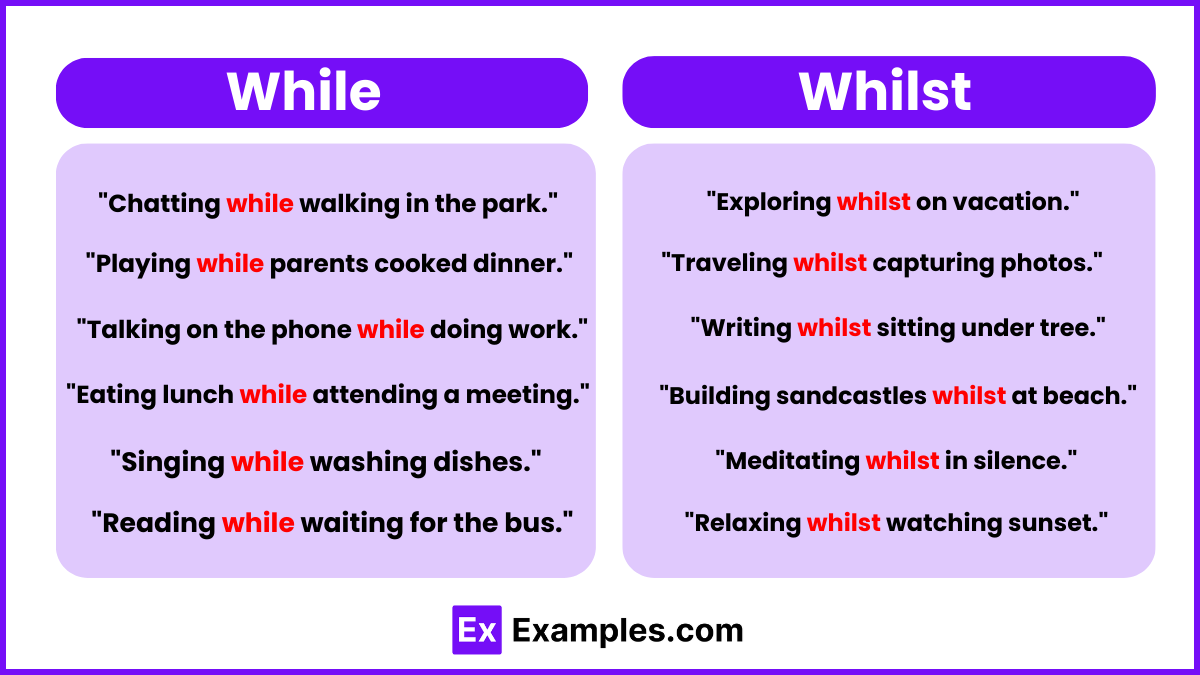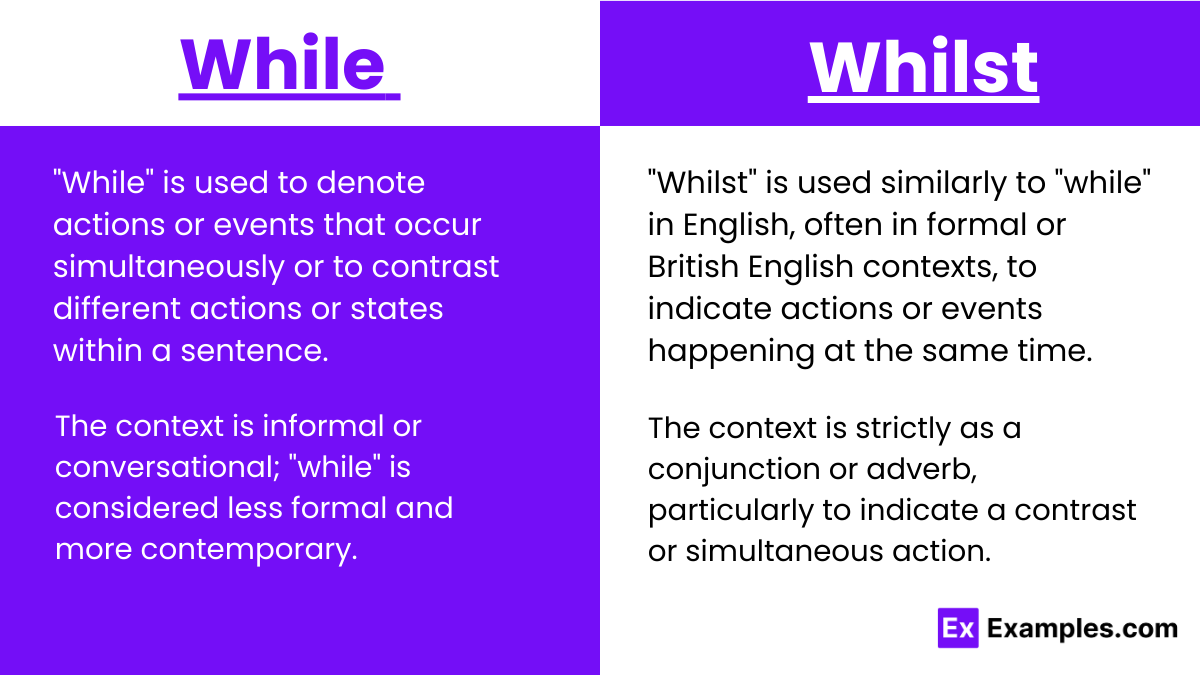While vs Whilst
The subtle dance of language often presents pairs of words like “while” and “whilst” that twirl through the English lexicon, almost mirroring each other yet stepping to distinct rhythms. These two conjunctions, serving to connect thoughts and indicate time or contrast, have long been a point of curiosity and sometimes confusion among students and language enthusiasts alike. The journey into understanding their usage is not just about grasping grammatical rules but also about appreciating the cultural and stylistic nuances that color our expressions.
In this exploration, we’ll unravel the threads that differentiate “while” from “whilst,” providing clarity to those embarking on the path of linguistic precision. This distinction is not merely academic; it reflects broader patterns of language evolution and regional preferences that shape how we communicate ideas. By the end of this article, students will not only recognize the functional interchangeability of these words but also develop an informed preference based on context, audience, and the desired tone of their writing.
While and Whilst – Meanings
While: “While” is a conjunction used in the English language to indicate a time period in which something happens or to contrast two different actions or states. It sets up a relationship between two events, often highlighting simultaneous occurrence or a contrast in actions or situations. For example, “She reads while he watches TV,” emphasizes activities happening at the same time, whereas “While I enjoy hiking, I dislike camping,” contrasts two preferences.
Whilst: “Whilst” shares the same meanings and functions as “while” and can be used interchangeably in most contexts. It is primarily used in British English and tends to appear more formal or literary. “Whilst” indicates simultaneous events or a contrast, much like “while.” An example of its use would be, “She prefers tea whilst her sister favors coffee,” showing a contrast in preferences.
Summary
“While” enjoys broader usage compared to “whilst,” with the latter often considered archaic in American English. Predominantly featured in British English, “whilst” is still less frequent than “while.” The versatility of “while” extends to its function as a conjunction, preposition, noun, or verb, offering a range of linguistic applications. In contrast, “whilst” serves more narrowly as a conjunction or adverb, limiting its utility. This distinction underscores the varying preferences and conventions that characterize English usage across different regions and contexts.
Difference Between While and Whilst
The English language is rich with words that, while similar at first glance, hold subtle distinctions that enrich its tapestry. Among these are “while” and “whilst,” two terms that often surface in discussions about language usage and regional dialects. “While” is widely embraced in both American and British English, known for its flexibility across various grammatical roles. “Whilst,” on the other hand, carries a hint of formality and is more commonly nestled within the folds of British English, though its usage has waned in comparison to its counterpart. This exploration aims to shed light on the nuanced differences between these terms, offering clarity to those navigating the intricacies of English.
| Aspect | While | Whilst |
|---|---|---|
| Usage Frequency | Predominantly used in both American and British English. | More common in British English; less frequent overall. |
| Grammatical Roles | Can function as a conjunction, preposition, noun, or verb. | Primarily used as a conjunction or adverb. |
| Regional Preference | Preferred in American English. | Favored in British English but considered somewhat archaic. |
| Formality | Considered neutral in terms of formality. | Often perceived as more formal or literary. |
| Contemporary Use | Widely accepted and used in modern English. | Seen as less modern, with restricted usage in contemporary text. |
| Versatility | Offers greater versatility in sentence construction. | Limited usage restricts its versatility in language. |
| Connotation | Neutral, without strong connotations of formality. | May carry connotations of antiquity or formal writing. |
| Commonality in Speech | Commonly used in everyday speech across various English dialects. | Less commonly used in speech, especially in informal contexts. |
| Literary Presence | Regularly appears in both literary and non-literary texts. | More likely to appear in literary or formal texts. |
| Perception | Viewed as a standard, universally accepted word. | Some may view it as pretentious or unnecessarily formal. |
Understanding these differences not only aids in choosing the appropriate term for a given context but also enriches one’s appreciation for the depth and diversity of English language expression.
Examples of While and Whilst
Examples of “While”
- While I was reading, the phone rang.
- She listens to music while she works.
- While many prefer coffee, some like tea.
- The city sleeps while the night comes alive.
- While you’re at the store, could you get some bread?
Examples of “Whilst”
- Whilst studying for his exams, he discovered his love for history.
- She enjoys walking whilst listening to podcasts.
- Whilst some argue for its efficiency, others question its impact.
- He found an old coin whilst gardening in the backyard.
- Whilst you consider your options, time is ticking away.
When to Use While and Whilst
Choosing between “while” and “whilst” often boils down to regional preference, stylistic considerations, and the formality of the context.
Usage of “While”
- You are writing for an American audience, as “while” is the preferred term in American English and is widely understood and accepted.
- You need a term that can function as a conjunction, preposition, noun, or verb, giving you flexibility in sentence construction.
- The context is informal or conversational; “while” is considered less formal and more contemporary.
- Clarity is paramount, as “while” is universally recognized and less likely to distract or confuse the reader.
Usage of “Whilst”
- Your audience is predominantly British or from regions where British English influences are strong, and you wish to align with local conventions.
- You aim for a more formal or traditional tone in your writing; “whilst” can impart an air of formality or literary flair.
- The context is strictly as a conjunction or adverb, particularly to indicate a contrast or simultaneous action.
Tips for While and Whilst
The choice between “while” and “whilst” can enhance the precision and style of your writing. Here are some tips to guide you:
- Know Your Audience: Use “while” for American audiences and “whilst” for British or regions influenced by British English. Adapt your choice to the preferences of your readers.
- Consider the Tone: “While” is versatile and fits well in both formal and informal contexts. “Whilst” tends to add a formal or slightly old-fashioned tone to your writing.
- Understand the Functions: Remember that “while” can serve as a conjunction, noun, verb, and preposition, making it more flexible. “Whilst” is primarily used as a conjunction or adverb.
- Context is Key: Use “while” when indicating a time duration or contrasting two actions. “Whilst” is best suited for showing contrast or conditions.
- Simplicity Matters: When in doubt, opt for “while.” It’s more universally understood and less likely to be seen as overly formal or outdated.
- Literary and Creative Writing: “Whilst” can add a distinctive flavor to literary or creative pieces, especially if you aim for a certain stylistic effect.
- Proofread and Edit: Always review your work. If “whilst” feels out of place or could potentially confuse your audience, consider replacing it with “while.”
- Stay Informed: Language usage evolves, and so do preferences for terms like “while” and “whilst.” Keep up with current trends in writing and speech to ensure your language remains relevant.
- Practice and Experiment: Use both “while” and “whilst” in different contexts to become comfortable with their nuances. This will also help you develop a sense of which word fits better in various situations.
- Seek Feedback: If possible, get feedback from others on your usage of “while” and “whilst.” Peer review can provide valuable insights into how your choices affect readability and style.
FAQs
Is it Whilst Working or While Working?
“Whilst working” is commonly used in British English, while “while working” is preferred in American English. Both phrases are correct, depending on your audience.
How Do You Use While Correctly?
Use “while” to indicate a period of time or to contrast two actions happening simultaneously. For example, “I listen to music while I work.”
When Did Whilst Become a Word?
“Whilst” has been in use since the 14th century, originating from Middle English. It serves as a formal or literary variant of “while,” particularly in British English.
What is the Rule for Using While?
The rule for using “while” involves signaling simultaneous actions (“I read while I eat”) or contrasting statements (“She loves tea, while I prefer coffee”).
Can I Use Whilst in Writing?
Yes, you can use “whilst” in writing, especially if you’re aiming for a formal tone or writing for a British audience. However, “while” is more universally accepted and understood





